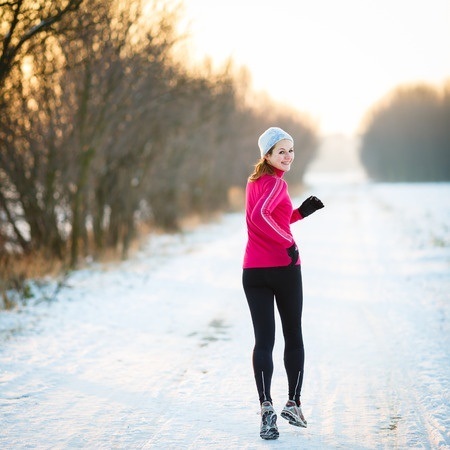
Cold weather doesn’t have to put the chill on your outdoor exercise plans this season. Sure, cooler temperatures and shorter daylight hours can sometimes dampen one’s enthusiasm to venture into the great outdoors this season, but they don’t necessarily have to put a stop to it.
Staying active during the winter is a great way to keep away the winter blues and combat cabin fever at the same time. Just ask winter sports enthusiasts who can’t wait for the mercury to drop this season! Even if participating in winter sports isn’t your cup of (hot) tea, it should be more than just cold comfort to know that the act of exercising is an effective way to stay warm!

Warming-up for the Cold
If you’ve ever tried starting a vehicle engine in freezing temperatures, you know it’s best to allow some time for things to warm up before driving off. The same principle applies to our bodies: Decreased body temperatures mean reduced reaction time, muscle contractility, and muscular contraction force, so someone who hasn’t warmed up stands a much greater risk of musculotendinous injury.
Warming up thoroughly before an activity helps to prevent muscle, tendon and ligament injuries. Start an activity by moving through the range of motions that your body will use to perform a given exercise and you’re less likely to become injured.
To prepare for exercise, consider the following guidelines:
- Warm-ups should be intense enough to cause a light sweat but not cause fatigue.
- Avoid doing any flexibility exercise until body temperature has been increased.
- If preparing for a specific activity, a warm-up should include movements similar to those used in that activity.
- If not preparing for a specific activity, light aerobic exercise or calisthenics can be effective before exercise.
Before heading outdoors for some winter recreation, remember that many accidents can be avoided with a bit of planning and some common sense.
The American Academy of Orthopaedic Surgeons offers the following the following tips for winter sports safety:
- Check the weather before heading outdoors. Pay attention to warnings about storms and severe drops in temperature. Make adjustments for icy conditions, deep or wet snow, and bad weather.
- Dress for conditions. It’s better to wear several layers of light, loose clothing that’s both water- and wind-resistant to stay safe, warm and dry than one or two bulky garments. And don’t forget appropriate safety gear – such as goggles and helmets – and make sure that all equipment is in proper working order before hitting the trails, slopes, or rink.
- Don’t go out alone. Venturing out with a partner is always a good idea in wintry weather – just be sure that you and the partner remain in each other’s sight. Letting someone know about your plans and you’re your destination before heading out, and carrying a cellphone is always a good idea in the event of emergencies.
- Stay hydrated by drinking water before, during and after outdoor activities.
- Seek shelter and medical attention if signs of hypothermia or frostbite affect you or a partner. Early symptoms of frostbite include numbness and tingling, lack of feeling and poor motion in your fingers or toes.
- If you’re in pain or feeling tired, give yourself permission to call it a day.
- Some days, the weather can be a real show stopper. When that happens, find ways to stay active indoors – at the gym or fitness center if you can get there, and at home if you can’t.







